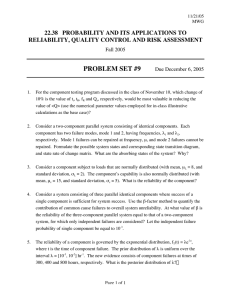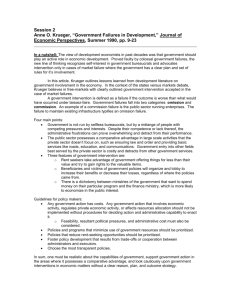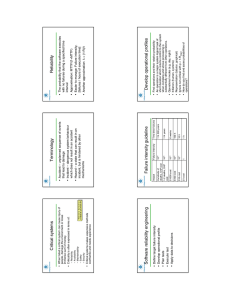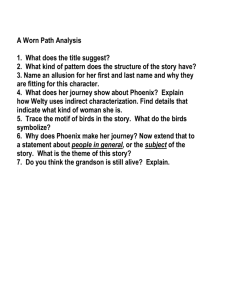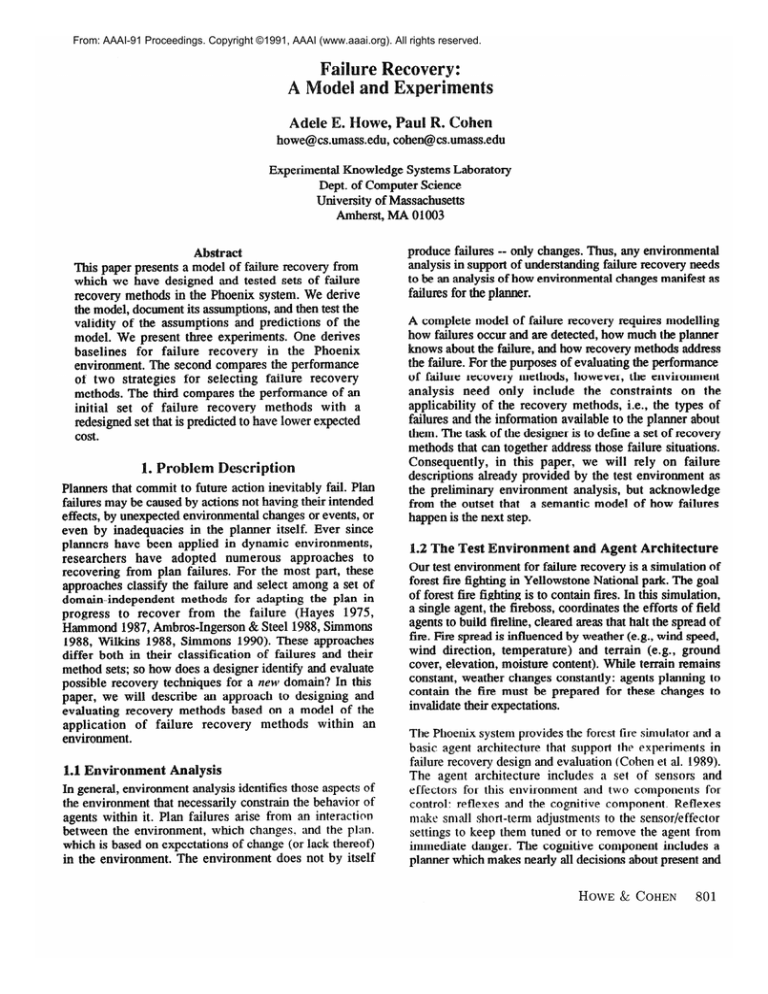
From: AAAI-91 Proceedings. Copyright ©1991, AAAI (www.aaai.org). All rights reserved.
howe@cs.umass.edu,
cohen@cs.umass.edu
Experimental Kuowledge Systems Laboratory
Dept. of Computer Science
University of Massachusetts
Amherst, MA 01003
This paper presents a model of failure recovery from
which we have designed and tested sets of failure
recovery methods in the Phoenix system. We derive
the model, document its assumptions, and then test the
validity of the assumptions
and predictions
of the
model. We present three experiments.
One derives
baselines
for failure
recovery
in the Phoenix
environment.
The second compares the performance
of two strategies
for selecting
failure recovery
methods. The third compares the performance of an
initial
set of failure
recovery
methods
with a
redesigned set
t is predicted to have Bower expected
cost.
Planners that commit to future action inevitably fail. Plan
failures may be caused by actions not having their intended
effects, by unexpected environmental
changes or events, or
even by inadequacies
in the planner itself. Ever since
planners have been applied in dynamic environments,
researchers
have adopted
numerous
approaches
to
recovering
from plan failures. For the most part, these
approaches classify the failure and select among a set of
domain-independent
methods for adapting the plan in
progress
to recover
from the failure
(I-Iayes 1975,
Hammond 1987, Ambros-Ingerson
& Steel 1988, Simmons
1988, Simmons 1990). These approaches
their classification
of failures and
; so how does a designer identify and evaluate
possible recovery techniques for a new domain? In this
paper, we will describe an approach to designing
and
evaluating
recovery methods based on a model of the
application
of failure
recovery
methods
within
an
environment.
In general, environment analysis identifies those aspects of
the environment that necessarily constrain the behavior of
agents within it. Plan failures arise from an interaction
between the environment,
which changes, and the plrln.
which is based on expectations of change (or lack thereof)
in the environment.
The environment
does not by itself
anges. Thus, any environmental
rstanding failure recovery needs
QW environmental changes mani6est as
failwres for the planner.
of failure recovery methods, however, the environment
analysis
need only include
the constraints
on the
applicability
of the recovery methods, i.e
failures and the information available to the
them. The task of the designer is to define a
methods that can together address those failure situations.
Consequently,
in this paper, we will rely on failure
descriptions already provided by the test environment
as
environment
analysis, but
owledge
that a semantic model of
failures
ur test environment fo
forest fire fighting in Yellowstone National park. The goal
to contain fires. In this simulation,
oss, coordinates t
fforts of field
line, cleared areas that
the spread of
fire. Fire spread is influenced by weather (e.g., wind speed,
wind direction,
temperature)
and terrain (e.g., ground
cover, elevation, moisture content).
le terrain remains
constant, weather changes constantly: agents planning to
contain the fire must be prepared for these changes to
invalidate their expectations.
The Phoenix system provides the forest tire simulator and a
basic agent architecture
that support the experiments
in
failure recovery design and evaluation (Cohen et al. 1989).
The agent architecture
includes
a set of sensors and
effecters for this environment
and two components
for
control: reflexes and the cognitive component.
Reflexes
rnC&e snA1 short-term adjustments to the sensor/effecter
settings to keep them tuned or to remove the agent from
ate danger. The cognitive component
a
which makes nearly all decisions about
d
HOWE
& COHEN
801
WATA
RV
RAV
Table 1. Failures and the applicabilities
future action. The planner
operates by lazy skeletal
expansion: it selects plans from a library and begins to
execute them, expanding some into more detailed action
sequences only as the need arises. Its plan language is
specific to this style of planning and its plan library is
specific to fire fighting.
Table 1 describes the possible failure situations that we
have observed in Phoenix. Each failure situation has a
name, such as not-enough-resources,
and a one-letter
identifier, used in later tables. Table 1 also indicates which
failure recovery methods (e.g., RP for replan-parent; to be
presented in Section 3.3) are applicable to each of the
failure situations. Table 1 shows, for example, that the RP
method is applicable to all failure situations; indeed, in the
baseline
experiments,
described
in Section 5.1, most
methods are applied in most failure situations.
SA
RP
RT
of failure recovery methods
We assume that failure recovery works by selecting a
method from a set of applicable methods and running that
method. If no methods are applicable
to a particular
situation, then C(Si) is defined to be the cost of outright
failure. If we assume that a method may fail, then for a
given situation, we may need to try several methods before
one works or we run out of methods. Given the probability
that each method will succeed in situation Si (P(MjlSi)),
and the cost of the method C(M*), the expected cost of
trying two methods in the order d j, Mk is as follows: The
cost of Mj and Mk are assessed regardless of whether they
succeed because methods run for the same amount of time
whether they succeed or fail. If both methods fail, C(F), the
cost of failure, is assessed. Thus, the expected cost of
attempting to execute Mj, Mk in situation Si, is:
EC(Si) =
C (MO)+ (1 - PouljISi)) C(Mk)
+ (I - &Mjei)) (I - P(MkISi))C(F
)
(2)
By the same argument
we can find the expected cost of
executing any sequence of methods in a situation Si :
The goal of failure recovery is to allow a plan to continue
from a failure, while incurring minimal overhead. The
previous section described possible failures in terms of
features. This section describes a model in which the
overall cost of recovery is a function of the probability of
failure situations
occurring
and the expected cost of
recovery methods.
EC(Si) =
C (Mj) + QW#i)
[C(Mk)
+ Q(Mj W K( 1)+ +--QOUW W’91-- 1
where Q(MjlSi) = 1 - P(MjlSi). So
recovery from a situation is the cost
in some order times the probability
having failed, accumulated
until
accepting outright failure.
(3)
the expected cost of
of trying the methods
of previous methods
the final option is
2.1 Basic Model
In the basic cost model, the expected cost of recovering
from any situation
is a cumulative
function
of the
probability
of a situation Si occurring times the cost of
recovering from it, for all situations:
EC = E P(Si)XC($i)
i= 1
(1)
where n is the number of situations
possible
in the
environment.
A situation
Si is a type of failure. The
probability
of a situation occurring P(Si) is empirically
determined for a given environment (see Sec. 5.2). C(Si) is
the expected cost of recovering from situation Si.
802
INTEGRATION AND RECOVERY
The assumptions
of this model are:
1) \J’m C(Mm) < C(F).
2) The cost of failure C(F) is independent of the
situation Si.
3) C(Mm) is independent of the order of execution of
the methods.
4) P(MmISi) is independent of the order of execution
of the methods.
5) The cost of each method C(Mm) is independent of
the situation Si.
Assumption
1 must be trivially true: there is no point in
failure recovery if it costs more than the failure itself (i.e.,
the cure is worse than the disease). Assumption 2 is very
difficult to test, and is not dealt with here. The validity of
set of
the other assumptions depends on the design of
methods, the environment in which they are used, and the
strategy by which the methods are selected. Assumpti
3-5 are tested in subsequent sections. We begin with
method selection strategy.
e best control s&ate
we
We can see from Eqs. 2 and 3 that
ure
try methods determines
the exp
recovery. For the case of two methods, we can easily derive
a rule for the minimum-cost
ordering. First we expand the
expressions for the expected cost of order Mj, Mk and
Mk, Mj, and then remove common terms:
ECjk =
C (M*ISi)+ (1 - P(MjlSi)) C(MlJSi)
+ (1 - &MjlSi)) (1 - P(MkISi))C(F ) )
= - P(MjlSi) C(Mk)
C (MlJSi)+ (1 - P(l@ISi)) C
+ (1 - P(MkISi)) (1 - P(MjSi)
= - P(MlJSi) C(Mj)
> ‘h”$ii’
, ECjk < EQj.
ii
Simon and Kadane (Simon and Kadane 1975) have proven
in the general case that expected cost of a sequence of
methods m is minimized
by- the strategy of trying the
P(MmlSi)
methods in order of descending
c(Mm) .
m
esign of Faiiure
Ot?lliX
The model of the previous section recommends minimizing
the cost of failure recovery by designing cheap methods
that always work. Since that it rarely possible, the model
can be used to focus design effort in several ways:
maximizing
the coverage
of methods so as to avoid
incurring the cost of failure; generalizing cheap methods to
apply in more situations, and adding new, cheaper methods
to the method set. We have designed and implemented a
recovery mechanism and a set of recovery methods for
Phoenix that attempt to follow these design guidelines.
3.
The Phoenix agent architecture includes three mechanisms
for detecting failures: execution
failures, reflexes, and
envelopesl.
Execution failures occur when a plan action
cannot execute to completion because conditions in the
environment
or plan do not match the expectations of the
current action. Reflexes are a reactive component of the
agent architecture
that trigger
timely
responses
to
threatening situations; the execution sf a reflex response
l(H
Because two of these mechanisms, reflexes and envelopes,
operate as adjuncts to the planning actions, they tend to
provide little information about the failure and its impact
Moreover, the Phoenix plan language itself is
Thus
d in its representation of cause and e
does
cause of failure, but only the
whatever information
an. We have avoided
more knowledge intensive, and therefore more predictable,
approaches to expl ’ g failures, such as in Hammond’s
CHEF (Hammond
1987) and Simmons’
GQRDIUS
(Simmons
1988), because the environment
and plan
interactions that cause failures are difficult to model and
analyze (see Sec. 5).
l
Eckj =
SO if
flags an execution
time failure in the on-going plan.
Envelopes detect impending failures (
Cohen 1990). They monitor
the plan’s progress
to
determine
wheth
the plan can complete
given
e environmental
conditions and its
expectations
about
resources.
owe & Cohen 1990) describes in further detail aspects of the
agent architecture designed to respond to change in the Phoenix
environment.
d, an action to deal with it is added
‘s agenda of actions and plans. Executing this
action results in calling the planner to find a plan (i.e.,
plauner searches a plan
) to address the failure.
library for methods applicable to the failure situation and
selects among them. In the experiments described below,
the planner is made to either select randomly among the
methods without replacement, or to select methods in the
optimum order, specified irn Section 2.2, above.
et
3.
To test the model, we de
d a core set of basic recovery
methods. These are the methods shown at the top of Table
ther global or I~call repairs to plans:
1.
ait aud try the failed action again.
Re-calculate
one variable use
variables used in
$A:
..
T:
failed
Substitute a similar plan step for the failed
action.
Abort current plan and re-plan at the parent
level (i.e., the level in the plan immediately
above this one).
Abort current plan and re-plan at the top level
(i.e., redo the entire plan).
The first four methods make local changes to the failed
action and surrounding actions; the last two replan at either
the next higher level of plan abstraction or at the top level.
These recovery methods, or ones very like them, have
appeared in other recovery systems. WATA is like the
“retry” method described in (Hanks & Firby 1990); RV and
RAV are Phoenix specific forms of SPPE’s Reinstantiate
HOWE
& COHEN
803
(Wilkins 1988); SA is applied in GORDIUS (Simmons
1988) and the two replan methods are constrained forms of
the more general replanning
done in nearly all failure
recovery systems.
4.
theses
m the expected cost model in
Several hypotheses follow
Eq. 3. These include tests of our assumptions from Section
2.1:
1) C(Mm) is independent of the order of execution of
the methods.
2) P(MmlSi) is independent of the order of execution
of the methods.
cost of each method C(Mm) is independent of
the situation Si.
We also test whether the model in Eq. 3 would facilitate the
redesign of a method set with a predicted lower expected
cost of failure recoverv:
4) Ordering the s&lection of fail= recovery me
RMrnW
by
-
C(Mrnl
- modifying the applicability conditions of
failure methods to reduce the applicability
expensive methods that are unlikely to
succeed
of
- modifying the set of failure methods to
include lower-cost methods
Moreover, the cost savings of these modifications
should be predictable from the model in E!q. 3.
In addition,
we are interested
in whether different
conditions in the Phoenix environment
lead to different
distributions of failure types.
We ran three sets of experiments.
In Experiment
1, we
collected baseline statistics to test hypotheses l-3, above,
and to empirically
determine values for the parameters
P(MmlSi),
P(Si) and C(Mm). In Experiment
2 we
compared the random and optimum method-selection
strategies (hypothesis 4, above).
In Experiment
3, we
added new recovery methods to more cheaply address
expensive recovery situations as suggested in hypothesis 5
and compared the results to those of Experiment 2.
1. Baselines.
We ran 116 trials in which Phoenix fought three fires,
resulting in 2462 failure situations and 5558 attempts to
recover from the failures. During these trials, the fires were
set at intervals of eight simulation hours. Wind speed and
wind direction were varied by f 3 kph and f 30 degrees,
respectively at one hour intervals. For each situation we
804
ent of the or&r of
Hypothesis I: C(Mm) is in
execution of the methods. We want to know whether
failure recovery methods have different costs depending on
their position in the order in which methods are executed.
We ran a two-way analysis of variance in which the factors
were method and position, and the dependent variable was
C(Mm). We analyzed separately failures in the Phoenix
fireboss
and Phoenix
bulldozers,
since the fireboss
encounters different types of fa.iIures which generally take
much longer to repair than bulldozer failures.
should result in a lower average cost
of failure recovery than a random method
selection strategy.
5) It should be possible to change the average cost of
failure recovery in all situations by
5.1 Experiment
collected the following data: the failure type, the failure
methods tried, the order in which the methods were tried,
and the cost (in simulation-time
seconds) of executing the
recovery methods and the plan modifications made by the
methods. The agents were given the recovery method set
and applicabilities
described in Table 1; in addition, the
bulldozer agents were given a special method for avoiding
a deadly object. The distribution
of method use was
essentially uniform, modulo the applicability
of the two
replan methods to an additional failure situation.
INTEGRATION AND RECOVERY
The bulldozer data produced a main effect of method,
indicating that different methods have different costs. But
the analysis found no significant effect of position, nor any
method by position interaction. The fireboss data yielded
main effects of cost and position
and a significant
interaction effect. Because we believed this to be due to
large variance in the costs for the replan methods, we
analyzed the data for the replans separately from the other
methods. As separate data sets, neither analysis of variance
found significant
interaction
effects, indicating
that the
replan methods behave qualitatively
differently from the
other methods and that for methods other than the replans,
the cost of a method is independent
of its order of
execution.
othesis 2: P(M,IS
ution of the metho
is ~~e~e~~e~t of the order of
o To test whether the probability
of a method’s success depends on its position in the order in
which methods are executed, we counted the number of
successes and failures for each method in each position in
which it was executed. and constructed contingency tables
from these counts.
(X-square
analyses for all but the two replan methods and
the substitute action method yield the same result: P(MilSi)
is independent of position. As in the testing of Hypothesis
1, the replan methods behave differently from the other
methods. Because the two replans are designed to take the
same action in some situations, when one replan method
fails, the other will as well: thus, the probability of success
for these methods is not independent
of which method
proceeded them. Similarly, we believe that the substitute
action method may be interacting
with one of the other
actions, but we have yet to test these explanations.
Table 2. Probabilities
and actual costs for baseline and strategy experiments,
in different situations, we ran a twoway analysis of variance in which the factors were method
and failure situation. As before, we analyzed fireboss and
bulldozer failures separately. The bulldozer data showed a
main effect of method (i.e., different
methods have
different costs), no effect of failure type, and no method by
failure interaction,
indicating that the cost of any given
method is independent of the failure situation in which it is
applied. As in the analysis of hypothesis 1, the fireboss data
was separated into global (i.e., the two replans) and local
(i.e., WATA., RV, RAV, and SA) methods. The an
these groups showed no method by failure interaction.
5.2 Experiment
2.
We ran 94 trials in which Phoenix fought three fires,
resulting in 2001 failure situations and 3877 attempts to
recover from the failures. We collected the same data about
each failure as in Experiment 1. The experiment scenario,
that is, wind changes and the intervals between new fires
were the same as in Experiment 1.
cost of ~a~~~~~
rewve
strategy. To test this hypothesis we used observed values
of P(MmISi) and mean values of C(Mm) derived from
Experiment 1 to determine P(MmlSi)/C(Mm),
from
we determined
the best order in which to try m
Using the mean for C(Mm) is justified by the fact that
C(Mm) is independent of situation and position.
Table 2 gives costs of failure recovery for each of the
failures, identified by capital letters as in Table 1. The
second row shows the costs incurred during the baseline
experiments
(Experiment
1). The fourth row shows the
actual mean costs under the optimum method selection
strategy for each failure situation. In all but situations H
and J, the cost of failure recovery is much lower (1 l-86%)
with the optimum strategy than with the random strategy.
as predicted.
Table 2 also includes the probability of occurence for each
of the failure types as observed in the two experiments.
produced
by situation.
a highly significant
result (z = -16.6, p e .OOOl).
lection of failure recovery methods by
gy results in a lower cost for most
a significantly lower cost overall.
As noted however, the cost of situation J increased, as well
as its probability of occuring. We believe
ese increases
are primarily due to changes made to the underlying system
during the intervening
time between the two experiment
sets.
resuhing in 1540 failure situations and 4279 attempts to
recover from the failures. We used the optimum strategy to
select methods. Ah other con tions were as they were for
Experiments 1 and 2.
Hypothesis
5 is that we can redesig
failure recovery methods to minimize
recovery. We could do so in two ways:
a. modify the
methods
methods
b. modify the set of failure methods to include Ilowercost methods
Because the strategy already selects methods to produce the
most efficient
ordering,
we chose to use the same
applicability conditions as in Experiment 2 (which results
in the method orderings shown in Table 3 ) turd augment the
failure method set. As in Table 1, rows represent failure
situations
and columns
represent
methods. The cells
contain the strategic ordering of the methods for each
failure situation, e.g., for situation G, fire-not-encircled,
the method selection order is SA, then RP, and finally RT.
We added two new methods for each of the agents,
designed by specializing some of the
to
perform better in those situations that
ve
HOWE
& COHEN
805
and likely (insufficient-progress, H, and cant-calculateprojection, 3, for the fireboss). The new methods, addanother-resource
(A&R) and substitute-projectionactions (SPA), were based on existing methods (RAV and
SA, respectively); consequently, the cost and probabilities
for them were copied from those methods and reduced
somewhat to reflect better expected performance, e.g., the
P(MmlSi) values were increased for the target situations.
The costs of failure recovery for the fireboss are shown in
Table 4. The new method set has managed to reduce the
cost of the target situations (B, II, and J) by 21%, 26% and
lo%, respectively ; yet, doing so incurred higher costs in
nearly all the other situations.
This produced a mean
recovery cost over all situations of 2370 with the new
method set. Consequently,
a z-test on the difference
between the means for Experiments
2 and 3 (2530 and
2370) was not significant (z = -1.00, p = .1587). Since we
made no changes to the method set which would account
for the increased costs in other situations,
we did not
predict this result and at present have no explanation for it
(see Section 7 for further discussion). As in Experiment 2,
a comparison of the new and old method set applied to
bulldozer errors resulted in a highly significant result (z =
6.57, p < .OOOl).
5.4 Another Baseline Experiment
To test the hypothesis
that the distribution
of failure
situations is independent of the environment conditions, we
recorded
the failures
that occurred
in two different
scenarios. In the fast-change scenario the windspeed and
wind direction changed every 30 minutes, the wind speed
by f2 kilometers/hour
and the wind direction by f 15
806
INTEGRATION AND RECOVERY
degrees;
three fires were set at 8 hour intervals..
In the
slow-change scenario the windspeed and the wind direction
changed every 60 minutes, by f 3 kph illtlc1f 30 degrees,
respectively, and three fires were set at 12 hour intervals.
Table 5 shows the distribution of failure situations (labelled
with letters, corresponding to the failure situations in Table
1) in the fast-change and slow-change scenarios.
S
A chi-square test shows that the distribution
of failure
situations is not independent of environmental
conditions
(x2(9) = 329.4, p < .OOOl). The fast-ch‘ange scenario
generates more errors (1 every 2.1 hours for fast: 2.8 hours
for slow; and 2.4 hours for the baseline); more importantly
it generates a different pattern of errors than the slowchange scenario. A complete model of failure recovery
should explain why particular failures are more or less
likely in different environmental
conditions; this is the goal
of our current research.
5.5 Experiment
Recap
We tested five hypotheses about the behavior of failure
recovery methods in a planner and one hypothesis about the
distribution
of failure situations in the environment.
The
independence
hypotheses described in Section 4 clearly
hold for the bulldozer agents, but the results are more
complicated
for the fireboss: The two replan methods
behave qualitatively differently fZromthe local methods. We
predicted and found that the optimal ordering strategy
results in a lower overall cost than the randon strategy. We
predicted that costs can be reduced by modifying the failure
recovery method set. While the method set modifications
did result in lower costs for the targeted situations and in a
lower overall cost, the difference
is not statistically
significant
due to increased
costs in other situations.
Consequently,
this hypothesis has yet to be conclusively
demonstrated or refuted. The last hypothesis assumed that
the distribution of failure situations is independent of the
environment
conditions.
In fact, we showed that the
distribution of failures is not independent of environmental
conditions,
in particular,
the rate of change in the
environment.
6. Discussion
The goal of these experiments was to test a model of failure
recovery performance
and demonstrate
that the model
could be used to direct the design of failure recovery in
novel environments. To that end, the most important result
from these experiments
is the insensitivity
of certain
properties of general methods to aspects of their execution
context:
cost is independent
of position
and failure
situation,
and probability
of success for a situation is
independent
of position
of execution.
While
the
independence
assumptions
have been tested only in the
Phoenix environment,
they held constant across the three
different environmental
change scenarios described in the
last section2 .
The experiments also disclosed basic differences between
the behavior of local (e.g., WATA, RV, RAV, and SA) and
global methods (e.g., RP and RT). Local methods are far
more predictable
(less variance
in cost), but have
correspondingly
lower probabilities of success. This leads
to a trade-off between predictability and power (probability
of success in this case). We believe that this trade-off is
general because so long as the scope of changes is small
and well-known
(i.e., predictable),
the probability
of
success will be limited to the likelihood that the source of
the failure is within the limited scope of the changes.
Conversely,
as the scope of changes
increases,
the
probability
of encompassing
the source of the trade-off
increases,
but the predictability
in cost reduces
correspondingly.
For the designer, the implications
are
2 We are eager to hear from other researchers
same results hold in their environments.
whether the
obvious: Lack of predictability
may not be tolerable in
environments with hard real-time deadlines; just as lack of
recovery success may be intolerable in environments
with
ex
right failures. For the Phoenix
en
strategy combined with the
recovery method set
cations has led to a strategy of
trying the local methods first, when they are
resorting to the global methods only after
specialized methods have been exhausted.
Over the course of these experiments,
guided the design of the recovery meth
agents. We started with a core set of general methods that
performed reasonably well. In fact, the overall recovery
rate (percentage of failures that are repaired) for the core
set of methods was at least 70% for aIll but one failure
situation in the baseline experiment; the lowest recovery
rate increased from 24% to 46% in the second experiment
with smaller improvements
in most of the other failure
types, and increased to 56% in the last (producing overall
recovery rates of 81%, 88% and 90% in Experiments 1, 2
and 3, respectively). Moreover, as stated earlier, the overall
cost of recovery decreased from 28 1 I to 2530 to 2370 with
the refinements to the recovery method set.
e high Bevel
of basic performance, subsequent improvements produced
from modifications
suggested
by the model, and the
independence
results demonstrate
that this model is
effective for iterative design of recovery method sets for
new environments.
We tested
the modifications
to the control of failure
in a single environment.
environmental conditions
failures, it remains to be
seen whether a method set designed
for one set of
conditions is appropriate to another. Based on the result9 of
the baseline experiments, it appears that an untuned set of
methods perform reasonably
well, but we have yet to
predict
how well a method
set will do when the
environment changes.
e agent architecture
for the Phoenix system includes
many components.
In this paper, we have described the
analysis and design of just one: failure recovery for the
planner. In designing
this component
for the Phoenix
environment
we analyzed the environment,
modelled the
behavior of the component with respect to its environment,
designed the component,
hypothesized
its behavior and
tested the hypotheses.
These five steps. along with
additional steps to revisit some of hypotheses based on
experiment
results
and to generalize
those results,
constitute
the MAD methodology
(Cohen 1991). We
believe these steps are necessary to the design and analysis
of AI systems.
As an understanding
weak. It is concerned
of failure recovery, our model is
only with the design and selection of
HOWE
& COHEN
807
a method set for an environment.
Other models of failure
recovery have addressed the role and form of individual
methods, specifically,
replanning.
Morgenstern’s
model
defines
a logical formalism for when it is necessary,
desirable and possible to replan
(Morgenstern
1987).
Kambhampati’s model of plan modification (Kambhampati
1990) guarantees completeness, coverage and efficiency for
replanning in hierarchical planners. Yet, we are still some
distance from a complete model of failure recovery.
It is an open question how complete our models must be:
To expedite design, we used mean costs from data with
considerable
variance, and still managed to improve the
design. In fact, the meastnes of cost and success were
subject to variation in part because their definitions are not
always clear. Local methods exert a local influence on the
plan; thus, we can easily determine
the scope of their
effects (e.g., cost and success). Global methods exert farreaching influence and so it is more difficult to arbitrarily
assign a horizon of influence to them. As suggested in the
discussions of independence results, global methods tend to
interact with one another and may produce downstream
effects that should change the evaluation of performance.
The next phase in this project will be to decompose these
measures into parameters that allow us to better predict
performance,
and through a semantic model, eventually
understand
how failures arise and how they are best
confronted (Howe, in preparation).
This research was supported by DARPA-AFOSR
contract
F49620-89-C-00113,
the Office of Naval Research, under a
University Research Initiative grant, ONR N00014-86-K
0764, and also under ONR NOOO14-88-K0009,
and the
National Science Foundation under an Issues in Real-Time
Computing grant, CDA-8922572.
We also wish to thank
David Westbrook and Scott Anderson for their invaluable
assistance in running the experiments and members of the
Phoenix project for the construction of the testbed.
eferences
Jose A. Ambros-Ingerson
and Sam Steel. 1988. Integrating
planning, execution and monitoring.
In Proceedings of the
Seventh National Conference on Artificial Intelligence,
Minneapolis,
Minnesota.
Paul R. Cohen.
1991. A survey of the eighth national
conference on artificial intelligence:
Pulling together or
pulling apart? AI Magazine, 12( 1).
Paul R. Cohen, Michael Greenberg, David M. Hart, and
Adele E. Howe. 1989. Trial by fire: Understanding
the
design requirements
for agents in complex environments.
AI Magazine, lO(3).
Kristian J. Hammond. 1987. Explaining and repairing plans
that fail. In Proceedings of the Tenth International Joint
808
INTEGRATION AND RECOVERY
Conference on Artificial Intelligence,
pages
109- 114,
Milan, Italy.
Steve Hanks and R. James Firby. 1990. Issues and
architectures
for planning
and execution.
In Katia P.
Sycara, editor, Proceedings of the Workshop on Innovative
Approaches to Planning, Scheduling and Control, pages
59-70. Morgan Kaufmann Publishers, Inc.
David
1990.
of plan
of the
M. Hart, Scott D. Anderson, and Paul R. Cohen.
Envelopes as a vehicle for improving the efficiency
execution. In Katia P. Sycara, editor, Proceedings
Workshop on Innovative Approaches to Planning,
Scheduling and Control, pages 71-76. Morgan Kaufmann
Publishers,
Inc.
Philip J. Hayes. 1975. A representation
for robot plans. In
Proceedings of the Fourth International Joint Conference
on Artificial Intelligence, Tiblisi, Georgia, USSR.
Adele E. Howe and Paul R. Cohen. 1990. Responding to
environmental
change.
In Katia P. Sycara, editor,
Proceedings of the Workshop on Innovative Approaches to
Planning, Scheduling and Control, pages 85-92. Morgan
Kautiann
Publishers, Inc.
Adele E. Howe. Adapting
Planning
to a Complex
Environment.
PhD Dissertation,
Dept. of Computer and
Information Science, Univ. of Massachusetts, forthcoming.
Subbarao
Kambhampati.
1990.
A theory of plan
modification.
In Proceedings of the Eighth National
Conference on Artificial Intelligence, pages 176-182,
Boston, MA.
1987. Replanning.
In Proceedings of
the DA.R?A Knowledge-Based Planning Workshop, pages
Leora Morgenstern.
5-l - 5-0, Austin, TX.
Reid C. Simmons. 1988. A theory of debugging plans and
interpretations.
IQ Proceedings of the Seventh National
Conference on Artificial Intelligence, Minneapolis,
MinResota.
Reid 6. Simmons. 1990. An architecture for coordinating
planning, sensing and action. In Katia P. Sycara, editor,
Proceedings of the Workshop on Innovative Approaches to
Planning, Scheduling and Control, pages 292-297. Morgan
Kaufmann Publishers, Inc.
Herbert A. Simon and Joseph B. Kadane. 1975. Optimal
problem-solving
search: All-or-none
solutions. Artificial
Intelligence Journal, 61235-247.
David E. Wilkins.1988. Practical Planning: Extending the
Cltrssicul AI Planning Paradigm.
Morgan Kaufmann
Publishers, Inc, Palo Alto, CA.


